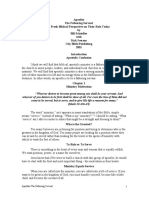Climate Change
Climate Change
Uploaded by
sparklinginwatersCopyright:
Available Formats
Climate Change
Climate Change
Uploaded by
sparklinginwatersCopyright
Available Formats
Share this document
Did you find this document useful?
Is this content inappropriate?
Copyright:
Available Formats
Climate Change
Climate Change
Uploaded by
sparklinginwatersCopyright:
Available Formats
Title: Addressing the Global Challenge of Climate Change: Understanding and Mitigating
Global Warming
Introduction: Global warming, a phenomenon characterized by the steady increase in the Earth's
average temperature, is one of the most pressing challenges facing humanity today. It is
primarily driven by the accumulation of greenhouse gases (GHGs) in the atmosphere, mainly
carbon dioxide (CO2) emitted from human activities such as burning fossil fuels, deforestation,
and industrial processes. This essay delves into the causes and consequences of global warming,
as well as potential solutions to mitigate its impacts.
Causes of Global Warming: The primary cause of global warming is the release of GHGs into
the atmosphere, which trap heat and lead to the greenhouse effect. The burning of fossil fuels for
energy production, transportation, and industrial activities is the largest contributor to CO2
emissions. Deforestation, which reduces the Earth's capacity to absorb CO2 through
photosynthesis, also exacerbates global warming. Additionally, other GHGs like methane (CH4)
from livestock farming and landfills, as well as nitrous oxide (N2O) from agricultural practices,
contribute to the problem.
Consequences of Global Warming: The impacts of global warming are wide-ranging and severe,
affecting ecosystems, weather patterns, and human societies. Rising temperatures lead to the
melting of polar ice caps and glaciers, resulting in sea-level rise and threatening coastal
communities with flooding. Extreme weather events, including heatwaves, droughts, hurricanes,
and heavy rainfall, become more frequent and intense, causing loss of life and property damage.
Changes in precipitation patterns affect agricultural productivity, leading to food shortages and
economic instability. Furthermore, shifts in ecosystems disrupt biodiversity and jeopardize the
survival of many species.
Mitigation Strategies: Addressing global warming requires concerted efforts at the individual,
community, national, and international levels. Transitioning to renewable energy sources such as
solar, wind, and hydroelectric power can significantly reduce CO2 emissions from energy
production. Improving energy efficiency in buildings, transportation, and industry further
decreases carbon footprints. Afforestation and reforestation initiatives help absorb CO2 and
restore degraded ecosystems. Additionally, adopting sustainable agricultural practices, reducing
food waste, and promoting plant-based diets can mitigate methane emissions from livestock and
decrease deforestation for agricultural expansion. International cooperation and policy measures,
such as carbon pricing, emissions trading schemes, and the Paris Agreement, are essential for
achieving global climate goals.
Conclusion: Global warming poses a grave threat to the planet and requires urgent action to
mitigate its impacts and safeguard future generations. By understanding the causes and
consequences of climate change and implementing effective mitigation strategies, we can
transition to a sustainable and resilient future. It is imperative that individuals, governments,
businesses, and civil society collaborate to address this global challenge and ensure the health
and well-being of both people and the planet.
You might also like
- CHESSDocument3 pagesCHESSJoseph R. Galleno100% (2)
- Reading B2 All DocumentsDocument18 pagesReading B2 All Documentsgaby1680No ratings yet
- Apostles The Fathering ServantDocument20 pagesApostles The Fathering ServantJose Humberto Zumarraga Novelo100% (3)
- Retort TechnologyDocument2 pagesRetort TechnologyjaseenaNo ratings yet
- Global WarningDocument2 pagesGlobal Warningmanikarthik1110No ratings yet
- Global WarmingDocument1 pageGlobal WarmingmicelforuniNo ratings yet
- Sample Essay2Document2 pagesSample Essay2manikarthik1110No ratings yet
- Global WarmingDocument2 pagesGlobal WarmingsaviourbilalNo ratings yet
- ArticleDocument2 pagesArticlek.v.malayNo ratings yet
- Global WarmingDocument2 pagesGlobal Warmingrmvy1818No ratings yet
- Text 2Document2 pagesText 269ttgc9djrNo ratings yet
- Global WarmingDocument2 pagesGlobal Warmingrudrakshjoshi07No ratings yet
- D 1Document2 pagesD 1jarymar.0No ratings yet
- Global Warming PPT by Fazil (Basic Communicative English)Document21 pagesGlobal Warming PPT by Fazil (Basic Communicative English)vedic competitivestudyNo ratings yet
- Global Warming Awareness For Business by SlidesgoDocument21 pagesGlobal Warming Awareness For Business by Slidesgovedic competitivestudyNo ratings yet
- Text 1Document3 pagesText 169ttgc9djrNo ratings yet
- Global Warming 3Document2 pagesGlobal Warming 3testtest1234No ratings yet
- IntroductionDocument3 pagesIntroductionronnyloyyNo ratings yet
- Understanding Global WarmingDocument2 pagesUnderstanding Global Warmingish paduaNo ratings yet
- Climate ChangeDocument3 pagesClimate ChangeSurajNo ratings yet
- EssayDocument4 pagesEssayKirubalini NagendranNo ratings yet
- WarmingDocument3 pagesWarmingronnyloyyNo ratings yet
- Global WarmingDocument4 pagesGlobal WarmingDipak VMNo ratings yet
- Global WarmingDocument4 pagesGlobal WarmingDanica VeniceNo ratings yet
- 1000 Word Essay About Global WarmingDocument3 pages1000 Word Essay About Global WarmingJean Romero100% (1)
- Gungoin A ViewDocument2 pagesGungoin A ViewkadadacNo ratings yet
- Global Warming: A Looming Threat To Our PlanetDocument2 pagesGlobal Warming: A Looming Threat To Our PlanetSolomon ObengNo ratings yet
- Climate Change and ImpactDocument2 pagesClimate Change and ImpactKAMORUDEEN SOKOYANo ratings yet
- Climate ChangeDocument2 pagesClimate Changedaria0506mariaNo ratings yet
- Climate ChangeDocument3 pagesClimate ChangetestmenowNo ratings yet
- Untitled DocumentDocument3 pagesUntitled Documentanikacherjee77No ratings yet
- Understanding Climate ChangeDocument3 pagesUnderstanding Climate Changeluffyxsenku1512No ratings yet
- Trolling 2Document2 pagesTrolling 2Liam CroutNo ratings yet
- Global WarmingDocument3 pagesGlobal Warmingmskrishnadevi0No ratings yet
- 1Document2 pages1Samip DhakalNo ratings yet
- Oral InglêsDocument2 pagesOral Inglês22834 Maria TeixeiraNo ratings yet
- Global Warming - 001Document2 pagesGlobal Warming - 001zbricks.postNo ratings yet
- Global WarmingDocument2 pagesGlobal Warmingmikaelanava90No ratings yet
- Global Warming A Comprehensive AnalysisDocument5 pagesGlobal Warming A Comprehensive Analysisa40198617No ratings yet
- Climate ChangeDocument2 pagesClimate Changehanskiprop15No ratings yet
- Formative 2Document2 pagesFormative 2sasaltolyNo ratings yet
- The Impact of Climate Change - A Global ChallengeDocument2 pagesThe Impact of Climate Change - A Global ChallengeparthyadavNo ratings yet
- Global Warming Problems Causing Global WDocument3 pagesGlobal Warming Problems Causing Global WWarona MorolongNo ratings yet
- Climate ChangeDocument2 pagesClimate ChangeThe OneNo ratings yet
- Essay #1Document2 pagesEssay #1MichelNo ratings yet
- Global WarmingDocument2 pagesGlobal WarmingEnvironment SpecialistNo ratings yet
- Sastav - Klimatske PromeneDocument3 pagesSastav - Klimatske PromeneAnita GrnjaNo ratings yet
- TitleDocument2 pagesTitleJaspher Carl BibatNo ratings yet
- Climate Change Essay SampleDocument2 pagesClimate Change Essay Sampleallabouthaikyuu123No ratings yet
- Global WarmingDocument3 pagesGlobal WarmingbinoybusnessNo ratings yet
- Research Paper On Global WarmingDocument4 pagesResearch Paper On Global WarmingADITYA SWYAMBHUNo ratings yet
- The Intensification of Global WarmingDocument2 pagesThe Intensification of Global Warmingmateonelan027No ratings yet
- Climate Change: A Call for Global Cooperation Understanding Climate Change: A Comprehensive GuideFrom EverandClimate Change: A Call for Global Cooperation Understanding Climate Change: A Comprehensive GuideNo ratings yet
- Global WarmingDocument2 pagesGlobal WarmingfoodpandaforeveryoneNo ratings yet
- Climate ChangeDocument2 pagesClimate ChangeEnrik ShenepremteNo ratings yet
- Climate Change and Its EffectsDocument2 pagesClimate Change and Its EffectsZofigan khawajaNo ratings yet
- EnvsciDocument5 pagesEnvsciHamdan AbisonNo ratings yet
- Global Warming - The Escalating Heat of Our PlanetDocument2 pagesGlobal Warming - The Escalating Heat of Our PlanetGuyNo ratings yet
- Climate ChangeDocument2 pagesClimate ChangeventronegiuliaNo ratings yet
- Climate Change (PT1)Document2 pagesClimate Change (PT1)bingovan12No ratings yet
- Climate Change and Its Global ImpactDocument6 pagesClimate Change and Its Global Impactkgnmk1997No ratings yet
- Greenhouse GasesDocument5 pagesGreenhouse GasesAmina KhalidNo ratings yet
- Global ProblemDocument2 pagesGlobal ProblemjfafkdiutbuvzgewtaNo ratings yet
- Everything You Need To Know About The Conjugation of "Essere" in ItalianDocument1 pageEverything You Need To Know About The Conjugation of "Essere" in ItalianTatjana MilosavljevicNo ratings yet
- Learning Plan: Analogy To Show Relationships of WordsDocument2 pagesLearning Plan: Analogy To Show Relationships of WordsMonaliza PawilanNo ratings yet
- TC4013Document3 pagesTC4013J. AguilarNo ratings yet
- Mahindra & Mahindra ProjectDocument75 pagesMahindra & Mahindra Projectnanda91100% (3)
- Lindt Phases 1 and 2Document30 pagesLindt Phases 1 and 2api-24727320550% (2)
- Comparison ASTMDocument8 pagesComparison ASTMSanti CheewabantherngNo ratings yet
- SR Eng Added Seen Passgaes With Key (Telangana)Document7 pagesSR Eng Added Seen Passgaes With Key (Telangana)medigachaithu9No ratings yet
- Module 1 - IspDocument14 pagesModule 1 - IspPratham JangraNo ratings yet
- Chapter - 5. Factorization of Algebraic ExpressionsDocument36 pagesChapter - 5. Factorization of Algebraic ExpressionsAnkit LadhaNo ratings yet
- Kudubu Turned DubukuDocument3 pagesKudubu Turned Dubukudeepthi chandrikaNo ratings yet
- 2015 Mainstreethost Digital Media Kit NPDocument23 pages2015 Mainstreethost Digital Media Kit NPTroy GatesNo ratings yet
- Stonproof CT5 Product Data - en - USDocument2 pagesStonproof CT5 Product Data - en - USVentas ExpertisNo ratings yet
- 23 Office AccountsDocument9 pages23 Office AccountsNguyenNo ratings yet
- Investor ReportDocument36 pagesInvestor ReportAlexandre CauetNo ratings yet
- G.R. No. 164815 September 3, 2009 Sr. Insp. Jerry C. Valeroso, Petitioner, Court of Appeals and People of The PHILIPPINES, RespondentsDocument4 pagesG.R. No. 164815 September 3, 2009 Sr. Insp. Jerry C. Valeroso, Petitioner, Court of Appeals and People of The PHILIPPINES, RespondentsMary Fatima BerongoyNo ratings yet
- Decide To Commit It.": Case of People of The R.P. vs. Pugay No. L-74324 17november1988Document2 pagesDecide To Commit It.": Case of People of The R.P. vs. Pugay No. L-74324 17november1988Ashley Kate PatalinjugNo ratings yet
- Roland Factory ResetDocument10 pagesRoland Factory ResetMiguel ReyesNo ratings yet
- Brochure Simatic Wincc v72 enDocument8 pagesBrochure Simatic Wincc v72 enjeanfmirandaNo ratings yet
- The Population BombDocument140 pagesThe Population BombHsien LouNo ratings yet
- CURMAP Tle9Document10 pagesCURMAP Tle9Lutchie Tancogo IINo ratings yet
- Cloud Computing and SaasDocument18 pagesCloud Computing and SaasSyairah HusnaNo ratings yet
- Krolikowski - Vertical Densification. The Structural Architecture of BBVA HQ Tower Mexico City - VoRDocument8 pagesKrolikowski - Vertical Densification. The Structural Architecture of BBVA HQ Tower Mexico City - VoROrcunNo ratings yet
- Present SimpleDocument3 pagesPresent SimpleclarasemitielbNo ratings yet
- Bai Doc (4567)Document6 pagesBai Doc (4567)ThanhdanNo ratings yet
- RaviDocument2 pagesRaviPoorna KalandharNo ratings yet
- Talmakkies Case Judgment Over Magistrate 21.11.2023Document17 pagesTalmakkies Case Judgment Over Magistrate 21.11.2023Krash KingNo ratings yet
- Menh de Quan He (Bai Tap)Document17 pagesMenh de Quan He (Bai Tap)Tan VuNo ratings yet

























































































